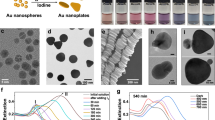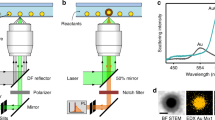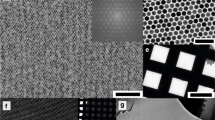Abstract
Inorganic nanoparticles exhibit size-dependent properties that are of interest for applications ranging from biosensing1,2,3,4,5 and catalysis6 to optics7 and data storage8. They are readily available in a wide variety of discrete compositions and sizes9,10,11,12,13,14. Shape-selective synthesis strategies now also yield shapes other than nanospheres, such as anisotropic metal nanostructures with interesting optical properties15,16,17,18,19,20,21,22,23. Here we demonstrate that the previously described photoinduced method23 for converting silver nanospheres into triangular silver nanocrystals—so-called nanoprisms—can be extended to synthesize relatively monodisperse nanoprisms with desired edge lengths in the 30–120 nm range. The particle growth process is controlled using dual-beam illumination of the nanoparticles, and appears to be driven by surface plasmon excitations. We find that, depending on the illumination wavelengths chosen, the plasmon excitations lead either to fusion of nanoprisms in an edge-selective manner or to the growth of the nanoprisms until they reach their light-controlled final size.
This is a preview of subscription content, access via your institution
Access options
Subscribe to this journal
Receive 51 print issues and online access
$199.00 per year
only $3.90 per issue
Buy this article
- Purchase on Springer Link
- Instant access to full article PDF
Prices may be subject to local taxes which are calculated during checkout



Similar content being viewed by others
References
Mirkin, C. A., Letsinger, R. L., Mucic, R. C. & Storhoff, J. J. A DNA-based method for rationally assembling nanoparticles into macroscopic materials. Nature 382, 607–609 (1996)
Bruchez, M., Moronne, M., Gin, P., Weiss, S. & Alivisatos, A. P. Semiconductor nanocrystals as fluorescent biological labels. Science 281, 2013–2016 (1998)
Han, M., Gao, X., Su, J. Z. & Nie, S. Quantum-dot-tagged microbeads for multiplexed optical coding of biomolecules. Nature Biotechnol. 19, 631–635 (2001)
Nicewarner-Peña, S. R. et al. Submicrometer metallic barcodes. Science 294, 137–141 (2001)
Cao, Y. C., Jin, R. & Mirkin, C. A. Nanoparticles with Raman spectroscopic fingerprints for DNA and RNA detection. Science 297, 1536–1540 (2002)
Schmid, G. Large clusters and colloids. Metals in the embryonic state. Chem. Rev. 92, 1709–1727 (1992)
Wang, J. F., Gudiksen, M. S., Duan, X. F., Cui, Y. & Lieber, C. M. Highly polarized photoluminescence and photodetection from single indium phosphide nanowires. Science 293, 1455–1457 (2001)
Sun, S., Murray, C. B., Weller, D., Folks, L. & Moser, A. Monodisperse FePt nanoparticles and ferromagnetic FePt nanocrystal superlattices. Science 287, 1989–1992 (2000)
Nirmal, M. et al. Fluorescence intermittency in single cadmium selenide nanocrystals. Nature 383, 802–804 (1996)
Henglein, A. Radiolytic preparation of ultrafine colloidal gold particles in aqueous solution: optical spectrum, controlled growth, and some chemical reactions. Langmuir 15, 6738–6744 (1999)
Brust, M. & Kiely, C. J. Some recent advances in nanostructure preparation from gold and silver particles: a short topical review. Colloid Surf. A 202, 175–186 (2002)
Korgel, B. A. & Fitzmaurice, D. Self-assembly of silver nanocrystals into two-dimensional nanowire arrays. Adv. Mater. 10, 661–665 (1998)
Talapin, D. V. et al. Dynamic distribution of growth rates within the ensembles of colloidal II–VI and III–V semiconductor nanocrystals as a factor governing their photoluminescence efficiency. J. Am. Chem. Soc. 124, 5782–5790 (2002)
Peng, X., Wickham, J. & Alivisatos, A. P. Kinetics of II–VI and III–V colloidal semiconductor nanocrystal growth: “focusing” of size distributions. J. Am. Chem. Soc. 120, 5343–5344 (1998)
Chang, S. S., Shih, C. W., Chen, C. D., Lai, W. C. & Wang, C. R. C. The shape transition of gold nanorods. Langmuir 15, 701–709 (1999)
Sun, Y. G. & Xia, Y. N. Shape-controlled synthesis of gold and silver nanoparticles. Science 298, 2176–2179 (2002)
Maillard, M., Giorgio, S. & Pileni, M. P. Silver nanodisks. Adv. Mater. 14, 1084–1086 (2002)
Maillard, M., Giorgio, S. & Pileni, M.-P. Tuning the size of silver nanodisks with similar aspect ratios: synthesis and optical properties. J. Phys. Chem. B 107, 2466–2470 (2003)
Pastoriza-Santos, I. & Liz-Marzan, L. M. Synthesis of silver nanoprisms in DMF. Nano Lett. 2, 903–905 (2002)
Chen, S. H., Fan, Z. Y. & Carroll, D. L. Silver nanodisks: synthesis, characterization, and self-assembly. J. Phys. Chem. B 106, 10777–10781 (2002)
Hao, E. C., Kelly, K. L., Hupp, J. T. & Schatz, G. C. Synthesis of silver nanodisks using polystyrene mesospheres as templates. J. Am. Chem. Soc. 124, 15182–15183 (2002)
Sun, Y. & Xia, Y. Triangular nanoplates of silver: synthesis, characterization, and use as sacrificial templates for generating triangular nanorings of gold. Adv. Mater. 15, 695–699 (2003)
Jin, R. et al. Photoinduced conversion of silver nanospheres to nanoprisms. Science 294, 1901–1903 (2001)
Kelly, K. L., Coronado, E., Zhao, L. L. & Schatz, G. C. The optical properties of metal nanoparticles: the influence of size, shape, and dielectric environment. J. Phys. Chem. B 107, 668–677 (2003)
Yang, W. H., Schatz, G. C. & Van Duyne, R. P. Discrete dipole approximation for calculating extinction and Raman intensities for small particles with arbitrary shapes. J. Chem. Phys. 103, 869–875 (1995)
Draine, B. T. & Flatau, P. J. Discrete-dipole approximation for scattering calculations. J. Opt. Soc. Am. A 11, 1491–1499 (1994)
Tang, Z., Kotov, N. A. & Giersig, M. Spontaneous organization of single CdTe nanoparticles into luminescent nanowires. Science 297, 237–240 (2002)
Penn, R. L. & Banfield, J. F. Imperfect oriented attachment: dislocation generation in defect-free nanocrystals. Science 281, 969–971 (1998)
Link, S., Burda, C., Mohamed, M. B., Nikoobakht, B. & El-Sayed, M. A. Laser photothermal melting and fragmentation of gold nanorods: energy and laser pulse-width dependence. J. Phys. Chem. B 103, 1165–1170 (1999)
Kamat, P. V. Photophysical, photochemical and photocatalytic aspects of metal nanoparticles. J. Phys. Chem. B 106, 7729–7744 (2002)
Acknowledgements
We acknowledge the use of a Cary 500 spectrometer in the Keck Biophysics Facility at Northwestern University. C.A.M and G.C.S. thank the AFOSR, ONR, DARPA and NSF for support of this work. R.J. is grateful for the support of the American Chemical Society Cognis Fellowship in Colloid and Surface Chemistry.
Author information
Authors and Affiliations
Corresponding authors
Ethics declarations
Competing interests
The authors declare that they have no competing financial interests.
Supplementary information
Rights and permissions
About this article
Cite this article
Jin, R., Charles Cao, Y., Hao, E. et al. Controlling anisotropic nanoparticle growth through plasmon excitation. Nature 425, 487–490 (2003). https://doi.org/10.1038/nature02020
Received:
Accepted:
Issue Date:
DOI: https://doi.org/10.1038/nature02020
This article is cited by
-
Photoinduced edge-specific nanoparticle decoration of two-dimensional tungsten diselenide nanoribbons
Communications Chemistry (2023)
-
A gold nanoparticles coated unclad single mode fiber-optic sensor based on localized surface plasmon resonance
Scientific Reports (2023)
-
Atomically precise gold nanoclusters at the molecular-to-metallic transition with intrinsic chirality from surface layers
Nature Communications (2023)
-
Influence of Photon and Electrical Energy in the Nucleation of Silver Nanoparticles Synthesis
Journal of Cluster Science (2023)
-
Optical Absorption Spectra of Star-Shaped Au–Ag Nanoparticles by Discrete Dipole Approximation Calculation Considering Highly Symmetrical Models
Plasmonics (2023)
Comments
By submitting a comment you agree to abide by our Terms and Community Guidelines. If you find something abusive or that does not comply with our terms or guidelines please flag it as inappropriate.



